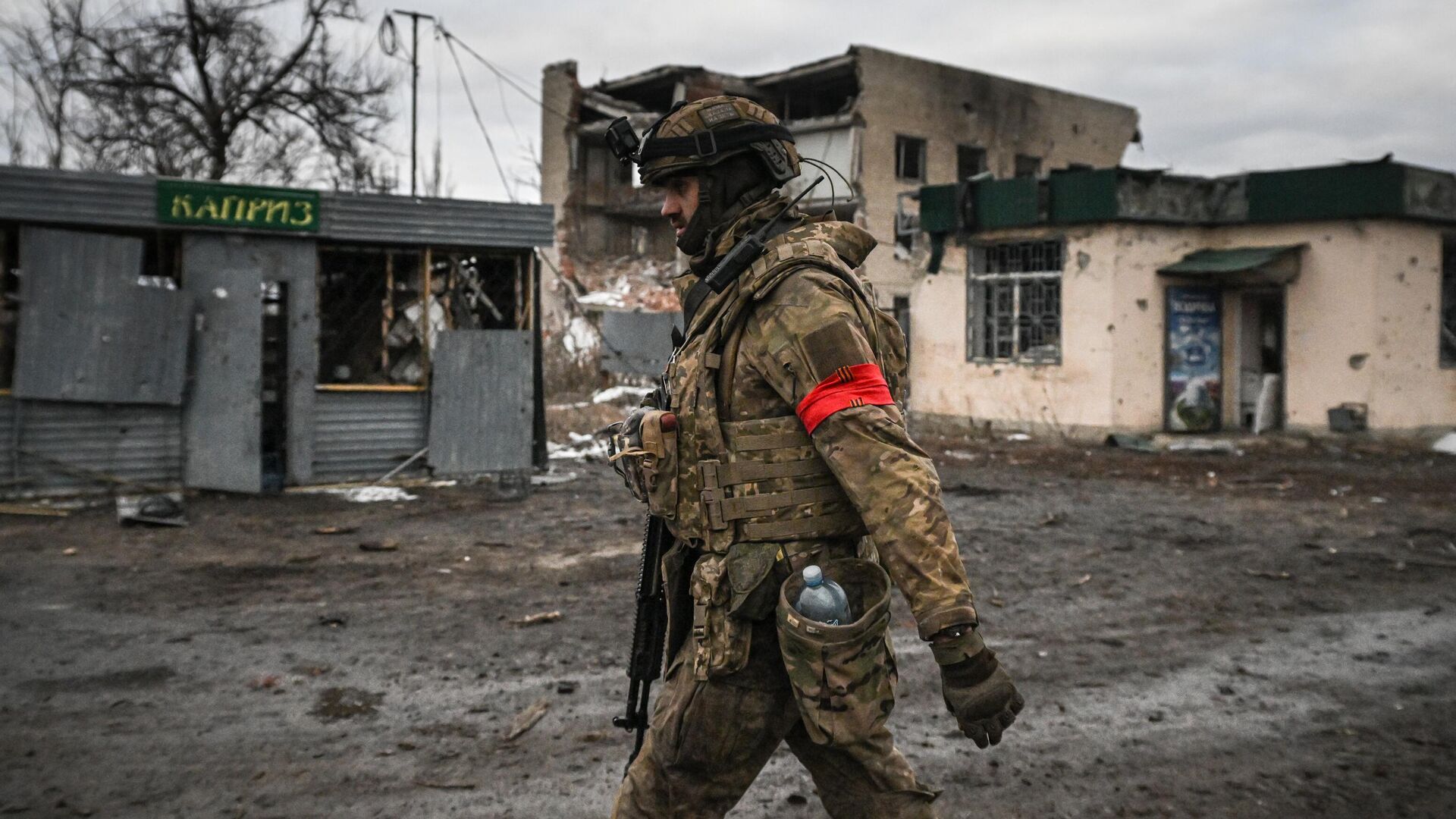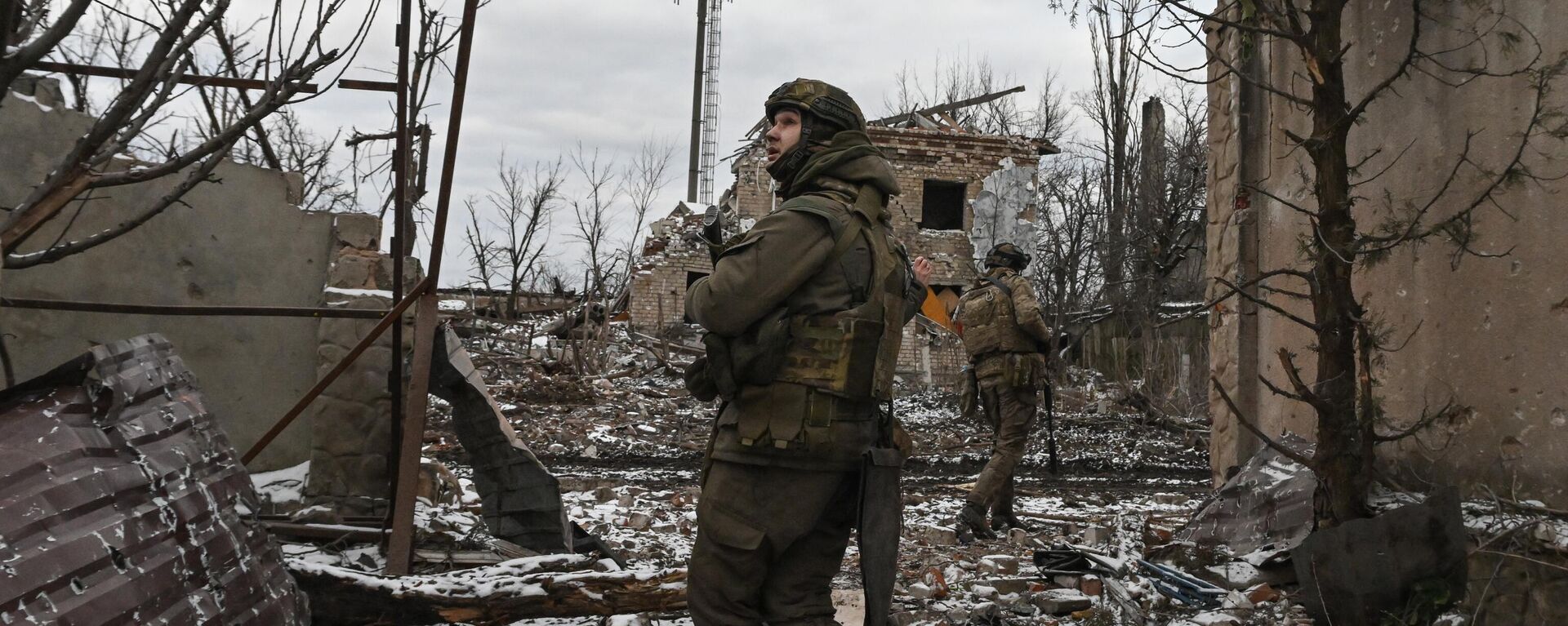https://sputnikglobe.com/20240221/how-avdeyevka-was-liberated-and-what-comes-next-1116895814.html
How Avdeyevka Was Liberated and What Comes Next
How Avdeyevka Was Liberated and What Comes Next
Sputnik International
International relations and security expert Mark Sleboda spoke with Radio Sputnik to explain how Russia liberated Avdeyevka and what he thinks comes next in the Special Operation.
2024-02-21T01:20+0000
2024-02-21T01:20+0000
2024-02-21T07:38+0000
analysis
mark sleboda
volodymyr zelensky
sergei shoigu
ukraine
avdeyevka
russia
armed forces of ukraine
starlink
https://cdn1.img.sputnikglobe.com/img/07e8/02/14/1116888970_0:150:3107:1898_1920x0_80_0_0_ec7c98670e841d46829384c77044de1b.jpg
The operation had been months in the making, progressing gradually before quickly accelerating as Ukrainian defenses crumbled in the South and North. This collapse led to the encirclement of the remaining Ukrainian forces stuck in the middle.“It was a rout,” Sleboda emphasized. “The order to retreat was only given two days after the Kiev regime troops en masse were abandoning their positions.”Sleboda explained that there were five major reasons why Ukraine lost what has been described by some military experts as “the most heavily fortified location on Earth.”Sleboda noted that this was the first operation in Ukraine where Russian soldiers actually outnumbered the enemy. “It wasn’t [the standard military rule of thumb for an offensive] six to one advantage in this conflict, but there definitely was a somewhat larger number of Russians,” he said, noting that the Russians were also of better quality. “There’s a lot of Kiev regime forces that were thrown in, especially at the end as attempted reinforcements that were territorial defense had been mobilized, forcibly conscripted just two weeks ago.”Sleboda said that there was also a lack of communication between Ukrainian commanders and the front line, possibly brought on by unconfirmed reports that Russian electronic warfare efforts cut Ukrainian soldiers off from Starlink services, which Ukraine uses to communicate over large distances. Sleboda called the reports “very credible” and that it resulted in “a lot of troops in the city [having] no idea what was going on at the end.”The fourth and fifth factors contributing to Avdeyevka’s liberation are interconnected, Sleboda said. They include Kiev's lack of air defenses and Russia’s heavy use of guided FAB long-range bombs.Those factors combined “shattered the morale” of Ukrainian troops, Sleboda said, noting that Kiev only gave the order to retreat “to save face” after troops were already abandoning their position.Sleboda said Ukrainian President Volodymyr Zelensky “was extremely angry” that Avdeyevka collapsed while he was at the Munich Security Conference. “He was extremely embarrassed,” Sleboda claimed, saying that Zelensky wanted to hold the city at least until the conference ended, if not the Russian Presidential elections next month.Asked what’s coming next, Sleboda noted that Russia does not like to advertise its war plans.Still, Sleboda predicts that Russian forces will soon move past Avdeyevka and capture the villages behind it, presumably referring to Orlovka, Severnoye, Tonenkoye and Stepovoye but possibly as far as the Karlovka Reservoir, the first significant natural barrier Ukraine could use for defense. “[Ukraine] did not build fortifications past Avdeyevka. In that direction there's no clear fortified line for the Kiev regime forces to retreat to,” he added, specifically saying that Novomikhailovka to the south of Avdeyevka should fall soon, noting that Russian soldiers are already in the eastern and southern parts of the town.Sleboda mentioned Ugledar as a possible goal, which he said the Russians could try to cut the supply lines to the “very tough, fortified position” that the Ukrainians have built there.“So this is going to lead to, at least locally, a cascading collapse over the next two months,” Sleboda predicted. He also speculated that Russia may work to erase the meager gains Ukraine made last year during its failed counteroffensive on other front lines, specifically pointing to Rabotino as a focus in the Zaporozhye direction where he said a “big force” has gathered. “That force could push as far as Orekhov, from which the [Ukrainian counteroffensive] was staged and maybe even Zaporozhye City," which is about 35 miles from Rabotino and 25 miles from the current frontline in Kamenskoye.Ivanovskoye and Chasov Yar, just outside of Artemovsk (fka Bakhmut) are also in danger of falling, Sleboda said. Operations in Ivanovskoye have been a focus in recent months, according to most military mappers, with Russian forces making gains in the town's North and West.Ultimately, Sleboda predicts that nothing will save Ukraine from eventual capitulation, even if its Western benefactors eventually provide their long-promised aid. “The US lacks the military-industrial capacity [to keep up with Russian production] and throwing a few tens of billions more dollars at the problem is not going to solve it in three to five years,” Sleboda explained. Instead, the bill being debated in the US Congress, which includes roughly $60 billion in aid for Ukraine, would only enable the Zelensky regime “To seize more people, more resources, more press gangs… abducting [people] off the streets, because no one is volunteering… [Ukraine’s recruits are] all unwilling civilians at this point.”
https://sputnikglobe.com/20240220/russian-general-staff-carried-out-operation-to-take-control-of-avdeyevka-with-minimal-losses-shoigu-1116891879.html
https://sputnikglobe.com/20240220/us-house-lawmakers-urge-colleagues-to-back-ukraine-aid--border-security-bill-1116885482.html
ukraine
avdeyevka
russia
Sputnik International
feedback@sputniknews.com
+74956456601
MIA „Rosiya Segodnya“
2024
News
en_EN
Sputnik International
feedback@sputniknews.com
+74956456601
MIA „Rosiya Segodnya“
Sputnik International
feedback@sputniknews.com
+74956456601
MIA „Rosiya Segodnya“
avdeyevka liberation, how did avdiivka fall? mark sleboda on ukraine, what happened in avdeyevka, ukrainian retreated from avdeyevka why, ukraine military disaster
avdeyevka liberation, how did avdiivka fall? mark sleboda on ukraine, what happened in avdeyevka, ukrainian retreated from avdeyevka why, ukraine military disaster
How Avdeyevka Was Liberated and What Comes Next
01:20 GMT 21.02.2024 (Updated: 07:38 GMT 21.02.2024) Late last week, Russian Minister of Defense Sergei Shoigu announced that Avdeyevka had been liberated by Russian forces, who captured the small city that had served as the stronghold for the Armed Forces of Ukraine for over ten years.
The operation had been months in the making, progressing gradually before quickly accelerating as Ukrainian defenses crumbled in the South and North. This collapse led to the encirclement of the remaining Ukrainian forces stuck in the middle.
“It was monthslong, but then when [the Ukrainians] broke, it broke [with a] kind of real quickness at the end,” Mark Sleboda, a foreign relations and security expert told Sputnik’s Fault Lines on Tuesday.
“It was a rout,” Sleboda emphasized. “The order to retreat was only given two days after the Kiev regime troops en masse were abandoning their positions.”
Sleboda explained that there were five major reasons why Ukraine lost what has been described by some military experts as “the most heavily fortified location on Earth.”
Sleboda noted that this was the first operation in Ukraine where Russian soldiers actually outnumbered the enemy.
“It wasn’t [the standard military rule of thumb for an offensive] six to one advantage in this conflict, but there definitely was a somewhat larger number of Russians,” he said, noting that the Russians were also of better quality.
“There’s a lot of Kiev regime forces that were thrown in, especially at the end as attempted reinforcements that were territorial defense had been mobilized, forcibly conscripted just two weeks ago.”The second reason, according to Sleboda was the “extreme shell hunger” that Ukraine has faced and continues to face. “This is an attrition war fought to a very large extent with artillery,” he explained.
Sleboda said that there was also a lack of communication between Ukrainian commanders and the front line, possibly brought on by unconfirmed reports that
Russian electronic warfare efforts cut Ukrainian soldiers off from Starlink services, which Ukraine uses to communicate over large distances. Sleboda called the reports
“very credible” and that it resulted in
“a lot of troops in the city [having] no idea what was going on at the end.”The fourth and fifth factors contributing to Avdeyevka’s liberation are interconnected, Sleboda said. They include Kiev's lack of air defenses and Russia’s heavy use of
guided FAB long-range bombs.
“In just the last few days, [Russia] dropped more than 300 [FABs] on Avdeyevka, I cannot imagine the delivery of that kind of munitions in that small of a space.”
Those factors combined “shattered the morale” of Ukrainian troops, Sleboda said, noting that Kiev only gave the order to retreat “to save face” after troops were already abandoning their position.
Sleboda said Ukrainian President Volodymyr Zelensky “was extremely angry” that Avdeyevka collapsed while he was at the Munich Security Conference. “He was extremely embarrassed,” Sleboda claimed, saying that Zelensky wanted to hold the city at least until the conference ended, if not the Russian Presidential elections next month.
Asked what’s coming next, Sleboda noted that Russia does not like to advertise its war plans.
“The Kiev regime does trailers and all of this fanfare and announces everything months in advance, and the glories sound the horns and whatever, right before their defeat. But Russia keeps everything absolutely operationally silent and the [Russian] Ministry of Defense never even mentioned the name Avdeyevka until they had liberated the city.”
Still, Sleboda predicts that Russian forces will soon move past Avdeyevka and capture the villages behind it, presumably referring to Orlovka, Severnoye, Tonenkoye and Stepovoye but possibly as far as the Karlovka Reservoir, the first significant natural barrier Ukraine could use for defense. “[Ukraine] did not build fortifications past Avdeyevka. In that direction there's no clear fortified line for the Kiev regime forces to retreat to,” he added, specifically saying that Novomikhailovka to the south of Avdeyevka should fall soon, noting that Russian soldiers are already in the eastern and southern parts of the town.
Sleboda mentioned Ugledar as a possible goal, which he said the Russians could try to cut the supply lines to the “very tough, fortified position” that the Ukrainians have built there.
“So this is going to lead to, at least locally, a cascading collapse over the next two months,” Sleboda predicted. He also speculated that Russia may work to erase the meager gains Ukraine made last year during its failed counteroffensive on other front lines,
specifically pointing to Rabotino as a focus in the Zaporozhye direction where he said a
“big force” has gathered.
“That force could push as far as Orekhov, from which the [Ukrainian counteroffensive] was staged and maybe even Zaporozhye City," which is about 35 miles from Rabotino and 25 miles from the current frontline in Kamenskoye.
Ivanovskoye and Chasov Yar, just outside of Artemovsk (fka Bakhmut) are also in danger of falling, Sleboda said. Operations in Ivanovskoye have been a focus in recent months, according to most military mappers, with Russian forces making gains in the town's North and West.
Ultimately, Sleboda predicts that nothing will save Ukraine from eventual capitulation, even if its Western benefactors eventually provide their long-promised aid.
“The US lacks the military-industrial capacity [to keep up with Russian production] and throwing a few tens of billions more dollars at the problem is not going to solve it in three to five years,” Sleboda explained. Instead, the bill being debated in the US Congress, which includes roughly $60 billion in aid for Ukraine, would only enable the Zelensky regime “
To seize more people, more resources, more press gangs… abducting [people] off the streets, because no one is volunteering… [Ukraine’s recruits are] all unwilling civilians at this point.”





